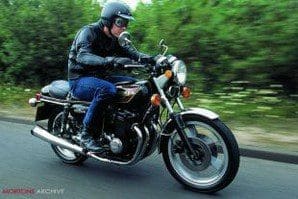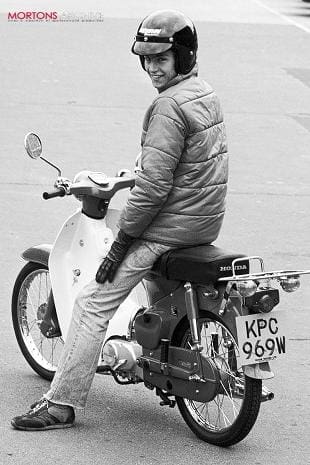
The might of Honda’s manufacturing empire was virtually built on the humble C50. While the days of the C50/70/90 step-thrus are numbered in Europe, they’re still popular in the Far East and they serve as the template for Lord knows how many imitations in China, Korea and Taiwan. Honda has built over 30 million of them. To repeat, 30 MILLION!
Cheap and reliable transport was the aim of the step-thru and Honda hit the target from the off. And with so many of them on the streets, reasonably priced spares are usually available at every car autojumble or junkyard. If you needed further persuading, think about the 120mpg that they’ll return (even the C90) to every pricey gallon of fuel.
Technically, you’ve got an sohc flat single (although the very first C100s were actually pushrod engined) with three speeds. Gear shift pattern on the old 50s and 70s is one up and two down, which comes as a surprise to some, while the 90 is all down – which is possibly even more confusing.
Oil feed to the top end seems to be mainly by a kind of scoop which throws lube everywhere but there is actually an oil pump as well. Filtration? A mesh screen behind the clutch cover is all you get. Points ignition, but in 1984 the C90 got 12 volts and (wow!) CDI ignition, and a year after that it gained an electric starter.
 It sounds silly talking about performance when you’re referring to step-thrus, but it always matters, doesn’t it? The 50cc model to go for is any 1970s model because from 1982 on it was detuned to comply with the 50cc learner restrictions. If it’s designated a C50LAC, it’s a slow one. The original unrestricted ones will hit the giddy heights of about 40 mph.
It sounds silly talking about performance when you’re referring to step-thrus, but it always matters, doesn’t it? The 50cc model to go for is any 1970s model because from 1982 on it was detuned to comply with the 50cc learner restrictions. If it’s designated a C50LAC, it’s a slow one. The original unrestricted ones will hit the giddy heights of about 40 mph.
The C70 has exactly the same engine as the Honda ST70 Dax. It’s thus a little bit quicker (say 45 mph) and has a shade more torque. Crashed C70s are in big demand because the head and barrel bolts straight onto the C50 (and the SS50 sports moped, ST50 Dax and other monkey bikes, come to that) for a performance boost. The trouble is that the C70 was discontinued in the late 1970s so you’ll be lucky to find one, let alone one in a good enough condition to be able to pilfer parts.
The C90 can manage about 55mph with a following wind but because the engines are completely different from the C50/70 lump, don’t think you can easily uprate your tiddler. The C90 was discontinued in 2002 and has been the favourite of London’s Knowledge Boys (people learning London’s streets as the essential cabbie training) for 20 years. All models are ludicrously economical.
Of course, they’re all clutchless. As you take up the pressure on the heel-and-toe gear lever, you engage the gears. Stamp it into first (they never had a slick gear change in all the years they made them) and simply open the throttle. The centrifugal clutch means you pull away as if you were on a moped and then all you do is stamp up and down the box. In practice, second gear is useful for anything over walking pace and you don’t need to change out of top until you’re doing 20 mph or below, so once up and running they can be used like automatics. They’ll all pull away in the higher gears but obviously you lose what little acceleration the thing had to begin with.
Oh, and excellent wheelies can be performed by maintaining pressure on the gear lever and then revving it hard before lifting your foot off the lever. Wa-hey! I’ve seen a C50 go vertical when treated like that.
The brakes are, and always have been, single leading shoe drums at either end. Leading link forks offer good torsional rigidity but seem to bounce on every road imperfection, and the rear shocks are just devoid of any meaningful damping. None of this matters a damn.
 What to look for
What to look for
Treated well (which means regular oil changes, preferably every 1000 miles), a Honda step-thru will just about last forever. Of course, many don’t get this sort of tlc. It shouldn’t smoke and it shouldn’t rattle. A rattling camchain is easily adjusted (the locknut and adjuster plunger are on the underside of the crankcases, on the left) but obviously casts doubt on how it’s been maintained.
The most vital thing to check is the rear mudguard, which is part of the frame and therefore structural. These have a tendency to rust through. If the corrosion is bad, then the rear shock mounts can fail. If it’s really severe, then the frame breaks. Either way, it can be extremely dangerous and a step-thru with a badly rusted rear end is fit only for scrap.
Chaincases seem to lose their lower halves – often because someone has tried to refit it and given up because it’s a fiddly job – and it’s easy to damage the little steel tongues that locate the two halves together. Spares are easily obtainable, so it’s not serious.
The big plastic leg shields are more brittle than you’d think and obviously bear the brunt of any crash. Again, they’re easily and cheaply replaced. Seats split and virtually every step-thru sold can be guaranteed to possess at least one cracked indicator lens (a couple of quid on ebay). Electrics are six-volt, of course, apart from C90s from 1984 on. There’s precious little to go wrong on them but it’s always worth checking the battery level because these are bikes that tend to be bought by the ignorant who assume that they’ll run for ever with no maintenance, like a Swatch. Amazingly, they’re almost right, but you really want to know it’s had some attention in its life.
Prices start low, so what are you waiting for?



